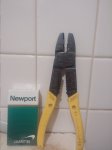Robert E Holt
Shohin
I'm looking to buy a good set of wire cutters. Looking at all that are available it's hard to figure out what to buy. I'm looking at the Kaneshin cutters. Thinking of starting with the #20 cutter since it can cut up to 14 gauge wire. However, I'm thinking that maybe something longer that make it easier o cut smaller wire from delicate branches might be a better investment.
Any thoughts before I buy? What is a common size that others use? Is there a particular range of wire sizes that get used most often?
Any thoughts before I buy? What is a common size that others use? Is there a particular range of wire sizes that get used most often?




